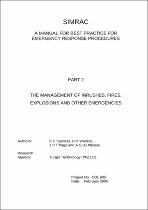 ResearchSpace
ResearchSpace
Manual for best practice for emergency response procedures, part 2: the management of inrushes, fires, explosions and other emergencies.
JavaScript is disabled for your browser. Some features of this site may not work without it.
- ResearchSpace
- →
- Research Publications/Outputs
- →
- Conference Publications
- →
- View Item
| dc.contributor.author |
Spencer, KC

|
|
| dc.contributor.author |
Walters, DM

|
|
| dc.contributor.author |
Page, TPT

|
|
| dc.contributor.author |
Du Plessis, AG

|
|
| dc.date.accessioned | 2007-11-09T06:37:49Z | |
| dc.date.available | 2007-11-09T06:37:49Z | |
| dc.date.issued | 2000-02 | |
| dc.identifier.citation | Spencer, KC, et al. 2000. Manual for best practice for emergency response procedures, part 2: the management of inrushes, fires, explosions and other emergencies. Safety in Mines Research Advisory Committee, COL 605, February, 2000, pp 1-11 | en |
| dc.identifier.uri | http://hdl.handle.net/10204/1466 | |
| dc.description.abstract | With the exception of those incidents that are solely attributable to nature, virtually all other incidents, the hand of man can usually be detected to a greater or lesser degree. It would be fair to say that if the myriad of laws, regulations, standards and Codes of Practice that govern mining operations were scrupulously adhered to, there would be very few untoward incidents. However, in reality, one must anticipate that, at times, things will go wrong and some times they will go badly wrong. It is therefore prudent that mine management, having done their best to prevent an incident occurring to begin with, have in place plans, facilities and equipment to manage the situation when the incident occurs. This is achieved by introducing and rigorously enforcing a system of Hazard Identification and Risk Assessment right down to the individual sections. Thereafter putting in place appropriate and if necessary, site specific Emergency Response Strategies and Procedures. By having a plan of action, facilities, all the necessary equipment in place, and a management team familiar with what they are required to do, the handling of any situation becomes much easier and the consequences of the incident invariably much reduced. What has become apparent is that a major programme of quality assurance is necessary to ensure that the standards, Codes of Practice and regulations are diligently put into practice, thus minimising the chances of a disaster. | en |
| dc.language.iso | en | en |
| dc.subject | SIMRAC | en |
| dc.subject | COL 605 | en |
| dc.subject | Hazard identification system | en |
| dc.subject | Risk assessment | en |
| dc.subject | Emergency response procedures | |
| dc.subject | Monitoring protocol | |
| dc.subject | Emergency guidelines | |
| dc.subject | Salient points | |
| dc.title | Manual for best practice for emergency response procedures, part 2: the management of inrushes, fires, explosions and other emergencies. | en |
| dc.type | Conference Presentation | en |
| dc.identifier.apacitation | Spencer, K., Walters, D., Page, T., & Du Plessis, A. (2000). Manual for best practice for emergency response procedures, part 2: the management of inrushes, fires, explosions and other emergencies. http://hdl.handle.net/10204/1466 | en_ZA |
| dc.identifier.chicagocitation | Spencer, KC, DM Walters, TPT Page, and AG Du Plessis. "Manual for best practice for emergency response procedures, part 2: the management of inrushes, fires, explosions and other emergencies." (2000): http://hdl.handle.net/10204/1466 | en_ZA |
| dc.identifier.vancouvercitation | Spencer K, Walters D, Page T, Du Plessis A, Manual for best practice for emergency response procedures, part 2: the management of inrushes, fires, explosions and other emergencies; 2000. http://hdl.handle.net/10204/1466 . | en_ZA |
| dc.identifier.ris | TY - Conference Presentation AU - Spencer, KC AU - Walters, DM AU - Page, TPT AU - Du Plessis, AG AB - With the exception of those incidents that are solely attributable to nature, virtually all other incidents, the hand of man can usually be detected to a greater or lesser degree. It would be fair to say that if the myriad of laws, regulations, standards and Codes of Practice that govern mining operations were scrupulously adhered to, there would be very few untoward incidents. However, in reality, one must anticipate that, at times, things will go wrong and some times they will go badly wrong. It is therefore prudent that mine management, having done their best to prevent an incident occurring to begin with, have in place plans, facilities and equipment to manage the situation when the incident occurs. This is achieved by introducing and rigorously enforcing a system of Hazard Identification and Risk Assessment right down to the individual sections. Thereafter putting in place appropriate and if necessary, site specific Emergency Response Strategies and Procedures. By having a plan of action, facilities, all the necessary equipment in place, and a management team familiar with what they are required to do, the handling of any situation becomes much easier and the consequences of the incident invariably much reduced. What has become apparent is that a major programme of quality assurance is necessary to ensure that the standards, Codes of Practice and regulations are diligently put into practice, thus minimising the chances of a disaster. DA - 2000-02 DB - ResearchSpace DP - CSIR KW - SIMRAC KW - COL 605 KW - Hazard identification system KW - Risk assessment KW - Emergency response procedures KW - Monitoring protocol KW - Emergency guidelines KW - Salient points LK - https://researchspace.csir.co.za PY - 2000 T1 - Manual for best practice for emergency response procedures, part 2: the management of inrushes, fires, explosions and other emergencies TI - Manual for best practice for emergency response procedures, part 2: the management of inrushes, fires, explosions and other emergencies UR - http://hdl.handle.net/10204/1466 ER - | en_ZA |





